Blogging Marvel’s Master of Kung Fu, Part Seven
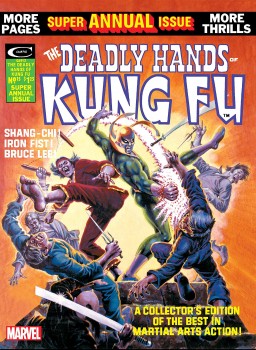 The continuing success of Warren Publishing’s Creepy, Eerie, and Vampirella led Marvel to relaunch its black & white magazine division in 1973. While the best of these Marvel Magazine titles supplemented the color comic line with material that could not easily be published in a monthly Code-approved title (Dracula Lives and Savage Sword of Conan, for instance) or offered unique material not spun-off as a companion title to a monthly (Planet of the Apes and Tales of the Zombie, among others), The Deadly Hands of Kung Fu sought a middle ground as a response to the martial arts craze that had taken America by storm on the silver screen, the small screen, comic books, and even the radio (Enter the Dragon, TV’s Kung Fu, Marvel’s Master of Kung Fu, and Carl Douglas’ novelty hit single “Kung Fu Fighting”).
The continuing success of Warren Publishing’s Creepy, Eerie, and Vampirella led Marvel to relaunch its black & white magazine division in 1973. While the best of these Marvel Magazine titles supplemented the color comic line with material that could not easily be published in a monthly Code-approved title (Dracula Lives and Savage Sword of Conan, for instance) or offered unique material not spun-off as a companion title to a monthly (Planet of the Apes and Tales of the Zombie, among others), The Deadly Hands of Kung Fu sought a middle ground as a response to the martial arts craze that had taken America by storm on the silver screen, the small screen, comic books, and even the radio (Enter the Dragon, TV’s Kung Fu, Marvel’s Master of Kung Fu, and Carl Douglas’ novelty hit single “Kung Fu Fighting”).
Master of Kung Fu may have been the lead feature at the start of the magazine’s run, but the title was never built solely around the continuing adventures of Shang-Chi alone. Articles, interviews, reviews, back-up strips, and reprints were just as important for a magazine that wanted not only to exploit the martial arts fad but also be taken seriously by martial arts students. For the purpose of our continuing series on Shang-Chi, we shall only be considering the black & white Master of Kung Fu strip that featured in most issues with passing reference to other material only where appropriate.
Deadly Hands of Kung Fu #1 launched in April 1974 with Master of Kung Fu as the lead feature written and illustrated by Shang-Chi’s creators Steve Englehart and Jim Starlin. Following just a few months after the character’s color comics debut in Special Marvel Edition #15, the story returned us to Shang-Chi’s early years in Honan, China when he trained as an assassin in service of his father. We see that as early as age fourteen, the seeds of doubt were sown in Shang-Chi as he questions the deadly violence of his martial arts training after learning from his mentor, Cho Lin that the assassins he dispatched who infiltrated the temple for the sole purpose of murdering the son of Fu Manchu were actually hired by his father as a lethal training exercise. The largest flaw here is that Starlin clearly drew Shang-Chi without knowledge that Englehart wanted him depicted as a fourteen year old. It is a nice touch to see that the deliberate manipulation of Shang-Chi by Cho Lin is intended as a slow fuse rebellion on his part. The monk recognizes that Shang-Chi will eventually reject his father’s doctrine and the deadly force that is Shang-Chi will be turned upon his maker.
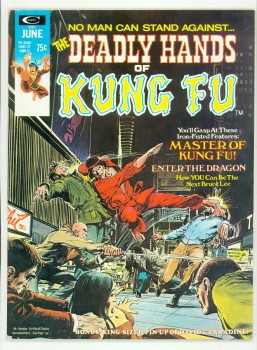 Deadly Hands of Kung Fu #2 sees Jim Starlin replaced by Alan Weiss for Steve Englehart’s bizarre story combining elements of Tod Browning’s disturbing and controversial 1932 film Freaks with H. G. Wells’ 1896 novel, The Island of Dr. Moreau. At first glance, one notices the monstrous Asian and African-American characters Weiss depicts are an unpleasant throwback to Golden Age comic art where rendering non-Caucasian characters as subhuman was an acceptable practice in the name of colonialism and wartime propaganda. While the influence of early Will Eisner and Jack Kirby is clearly deliberate, the grotesque characters are supposed to be literal monster-men as they are living results of Fu Manchu’s experimentation with human and animal life. These renegades have banded together and live in a backroom of a New York martial arts studio where they plot revenge against Fu Manchu. Unfortunately, they are unaware Shang-Chi has turned against his father and are determined to destroy the man who should be their greatest ally. Englehart’s script does a nice job of making the reader appreciate that their physical deformities pale compared to the psychological scarring they have received which points inevitably toward a tragic finish. The story was to mark Englehart’s last for the black & white magazine and his successor was the man who did so much to make Master of Kung Fu such a success as a color monthly for Marvel.
Deadly Hands of Kung Fu #2 sees Jim Starlin replaced by Alan Weiss for Steve Englehart’s bizarre story combining elements of Tod Browning’s disturbing and controversial 1932 film Freaks with H. G. Wells’ 1896 novel, The Island of Dr. Moreau. At first glance, one notices the monstrous Asian and African-American characters Weiss depicts are an unpleasant throwback to Golden Age comic art where rendering non-Caucasian characters as subhuman was an acceptable practice in the name of colonialism and wartime propaganda. While the influence of early Will Eisner and Jack Kirby is clearly deliberate, the grotesque characters are supposed to be literal monster-men as they are living results of Fu Manchu’s experimentation with human and animal life. These renegades have banded together and live in a backroom of a New York martial arts studio where they plot revenge against Fu Manchu. Unfortunately, they are unaware Shang-Chi has turned against his father and are determined to destroy the man who should be their greatest ally. Englehart’s script does a nice job of making the reader appreciate that their physical deformities pale compared to the psychological scarring they have received which points inevitably toward a tragic finish. The story was to mark Englehart’s last for the black & white magazine and his successor was the man who did so much to make Master of Kung Fu such a success as a color monthly for Marvel.
Deadly Hands of Kung Fu #3 sees Doug Moench’s debut as Master of Kung Fu is relegated to the support feature rather than the lead. This marks an inauspicious debut for Moench and Paul Gulacy in the pages of the black & white title. It is likely Moench was unaware that Jim Starlin’s last script likewise began with Shang-Chi coming to the aid of a beautiful young woman being menaced by thugs in a dark alley. Happily, the stories divert from there as Shang-Chi stumbles into the Chinatown lair of The Adder, a colorfully named heroin pusher in the pay of Fu Manchu who is determined to eliminate the one person who could expose his true identity to the authorities, his own daughter. The parallels between the unfortunate young woman and her heinous father with Shang-Chi and Fu Manchu are nicely handled and leave the reader wishing for an expanded page count. Paul Gulacy’s more familiar art is a welcome sight for someone who has already worked their way through the first couple years of the monthly title.
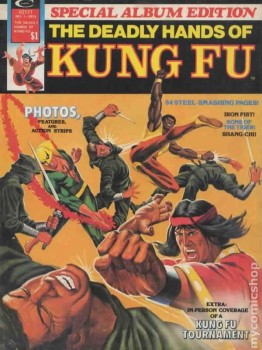 Deadly Hands of Kung Fu Special Album Edition #1 was the hastily assembled Annual pulled together after only three issues had seen print. The Annual offered a loosely-connected story arc threading three strips: Iron Fist, Sons of the Tiger, and Master of Kung Fu with Fu Manchu’s plot to abduct Chinese and American U.N. delegates during a peace conference in order to pit both nations against the other. The three stories are basically self-contained and no crossover occurs to allow the heroes to meet one another. Shang-Chi’s concluding chapter is mainly notable for marking the first pairing of Doug Moench with artist Mike Vosburg who will become the regular artist on the magazine. Sir Denis Nayland Smith and Black Jack Tarr are brought in for the finale. The storyline of all three chapters in this Annual is the first in the black & white magazine to approach the scope (if not the quality) of the monthly title. The Annual is perhaps most notable for David Anthony Kraft’s text piece on Sax Rohmer and the history of Fu Manchu in print and film.
Deadly Hands of Kung Fu Special Album Edition #1 was the hastily assembled Annual pulled together after only three issues had seen print. The Annual offered a loosely-connected story arc threading three strips: Iron Fist, Sons of the Tiger, and Master of Kung Fu with Fu Manchu’s plot to abduct Chinese and American U.N. delegates during a peace conference in order to pit both nations against the other. The three stories are basically self-contained and no crossover occurs to allow the heroes to meet one another. Shang-Chi’s concluding chapter is mainly notable for marking the first pairing of Doug Moench with artist Mike Vosburg who will become the regular artist on the magazine. Sir Denis Nayland Smith and Black Jack Tarr are brought in for the finale. The storyline of all three chapters in this Annual is the first in the black & white magazine to approach the scope (if not the quality) of the monthly title. The Annual is perhaps most notable for David Anthony Kraft’s text piece on Sax Rohmer and the history of Fu Manchu in print and film.
Deadly Hands of Kung Fu #4 returned Master of Kung Fu to the lead feature for a decidedly offbeat Doug Moench-Mike Vosburg tale involving Chow Loo, an unsuccessful Si-Fan assassin whose life is spared by Shang-Chi only to suffer a cruel fate when he attempts to deceive Fu Manchu to buy himself more time to complete his assignment. Mike Vosburg’s penchant for drawing stunningly beautiful women is on display here with his rendering of Ducharme, the mistress of Fu Manchu created by Marvel for the monthly comic. Ducharme’s opium addiction is portrayed much more graphically here freed of Code restraints than Gulacy could ever have done in the monthly book. There is also a noteworthy interlude where Shang-Chi travels across country by hitchhiking a ride with a hippie couple. Their pot smoking is featured heavily in another sign of the magazine taking advantage of its freedom from Code restrictions. This is actually anything but a filler story for Shang-Chi will remain in California for the next several issues of the magazine which was now beginning to establish its own continuity outside of the monthly color title. An unpleasant encounter with bikers who nearly rape and murder the hippie couple is the beginning of a recurring theme for the series as Moench allows Shang-Chi to do what countless bullied victims have wanted to do forever. This would also become a recurring theme in the pages of The Incredible Hulk and, even more explicitly, in its own companion magazine title. The story’s grotesque finale revealing Chow Loo’s fate is further proof that Doug Moench had begun reading Rohmer and working to incorporate more of his concepts into the series.
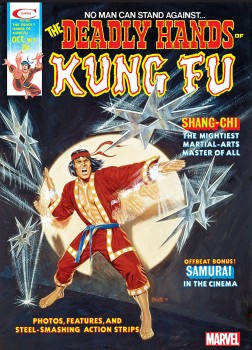 Issue #5 sees Keith Pollard substituting for Mike Vosburg for an interesting filler which sees a disappointed Shang-Chi squirming in his seat in an L.A. theater while watching an unrealistic martial arts film called “Fists of Hate” when he recognizes the film’s star, Kwai Loo as a fellow student at Fu Manchu’s Honan retreat. A flashback shows how Shang-Chi’s defeat of Kwai Loo during a martial arts contest put him on the path that led him away from the Si-Fan to the shallow facade of Hollywood. Shang-Chi pays a visit to the studio where Kwai Loo is filming his latest martial arts exploitation quickie for a Caucasian director who cares little for authenticity and even less for his actors’ safety. Of course, the past always catches up with people and Kwai Loo is no exception for Shang-Chi was not the only one to recognize him on the silver screen. Moench’s script mixes Hollywood lore from George Raft to John Bindon to Bruce Lee in the story’s portrayal of organized crime and the film world making for a deadly combination. Moench is also explicitly commenting about Robert Clouse in his character of the movie director who sees nothing wrong with exploiting unused footage of his star after his tragic death on the set of their latest film.
Issue #5 sees Keith Pollard substituting for Mike Vosburg for an interesting filler which sees a disappointed Shang-Chi squirming in his seat in an L.A. theater while watching an unrealistic martial arts film called “Fists of Hate” when he recognizes the film’s star, Kwai Loo as a fellow student at Fu Manchu’s Honan retreat. A flashback shows how Shang-Chi’s defeat of Kwai Loo during a martial arts contest put him on the path that led him away from the Si-Fan to the shallow facade of Hollywood. Shang-Chi pays a visit to the studio where Kwai Loo is filming his latest martial arts exploitation quickie for a Caucasian director who cares little for authenticity and even less for his actors’ safety. Of course, the past always catches up with people and Kwai Loo is no exception for Shang-Chi was not the only one to recognize him on the silver screen. Moench’s script mixes Hollywood lore from George Raft to John Bindon to Bruce Lee in the story’s portrayal of organized crime and the film world making for a deadly combination. Moench is also explicitly commenting about Robert Clouse in his character of the movie director who sees nothing wrong with exploiting unused footage of his star after his tragic death on the set of their latest film.
Issue #6 brings back Mike Vosburg to illustrate another of Doug Moench’s biker revenge fantasies. This time, Shang-Chi stops by a burger joint to sample a cheeseburger for the first time in his life (he opts just for french fries upon learning a burger is made from cow meat) when he has an unfortunate encounter with bikers that is exacerbated by their leader’s flirtatious girlfriend. Moench was building towards bigger statements on violence and the sanctity of life from a Buddhist perspective. As it is, this issue is simply a step towards this larger goal and, from that perspective, may justify it being relegated to the support feature for the second time in the magazine’s first year of existence.
Issue #7 sees Doug Moench experimenting with narrative construction in a tale that brings back the vengeful mutations from Issue #5 and mixes them in with a story seeing Shang-Chi run afoul of the Mafia. Mike Vosburg’s art gives him a chance to finally render Fu Manchu and Peko with the same ornate care of his illustrations in the recent Rohmer biography, Master of Villainy or in the contemporaneous fanzine, The Rohmer Review. As always, his rendering of Ducharme was nothing short of lovely.
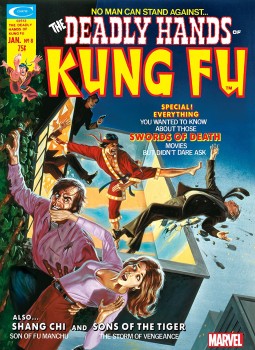 Issue #8 offers one of Doug Moench’s best scripts for the magazine and also a highly sophisticated opening sequence from Mike Vosburg that cuts quite literally between two characters delineating the differences in life from opposite sides of the track. This sort of story became quite typical of Batman under Denny O’Neil’s run on the series, but the evident influence does nothing to undermine the strength of Moench’s writing. The focus is the social understanding of the psychopath as victim of unrelenting abuse who perpetuates the cycle as they mature by inheriting the role of abuser. Just as Neal Adams would do for Denny O’Neil in similar Dark Knight tales, Vosburg depicts the psychopath as a monstrous overgrown child with Vosburg emphasizing the influence of the Boris Karloff interpretation of the Monster of Frankenstein.
Issue #8 offers one of Doug Moench’s best scripts for the magazine and also a highly sophisticated opening sequence from Mike Vosburg that cuts quite literally between two characters delineating the differences in life from opposite sides of the track. This sort of story became quite typical of Batman under Denny O’Neil’s run on the series, but the evident influence does nothing to undermine the strength of Moench’s writing. The focus is the social understanding of the psychopath as victim of unrelenting abuse who perpetuates the cycle as they mature by inheriting the role of abuser. Just as Neal Adams would do for Denny O’Neil in similar Dark Knight tales, Vosburg depicts the psychopath as a monstrous overgrown child with Vosburg emphasizing the influence of the Boris Karloff interpretation of the Monster of Frankenstein.
Shang-Chi’s inability to resolve violence with reason is in keeping with Moench’s recurring theme for the series. The unending cycle of violence has been present nearly since the book’s inception and points toward an inevitable rejection of Western storytelling tradition once Shang-Chi has suffered enough tragedy to reject combat as a viable solution to conflict. Despite milking the market for a new character with not only a monthly title, but a quarterly title and a bi-monthly non-Code magazine; in Shang-Chi, Marvel had created a character who was fated to abandon his efforts to conform to Western concepts of strength. The loyal reader’s enjoyment becomes less about the series’ adherence to formula than it is about seeing how long the series can postpone the inevitability of fate.
William Patrick Maynard is a writer and film historian. His commentaries have appeared on releases from MGM, Shout Factory, and Kino-Lorber. He is the authorized continuation writer for the Sax Rohmer Literary Estate and is the author of new Fu Manchu thrillers for Black Coat Press.